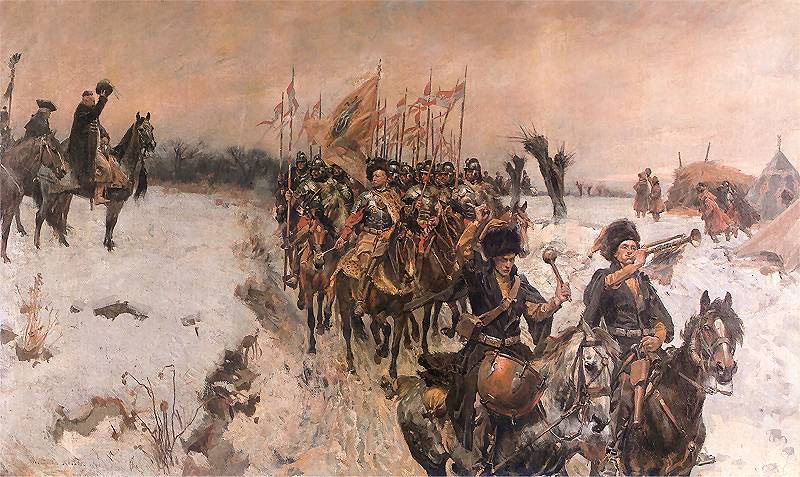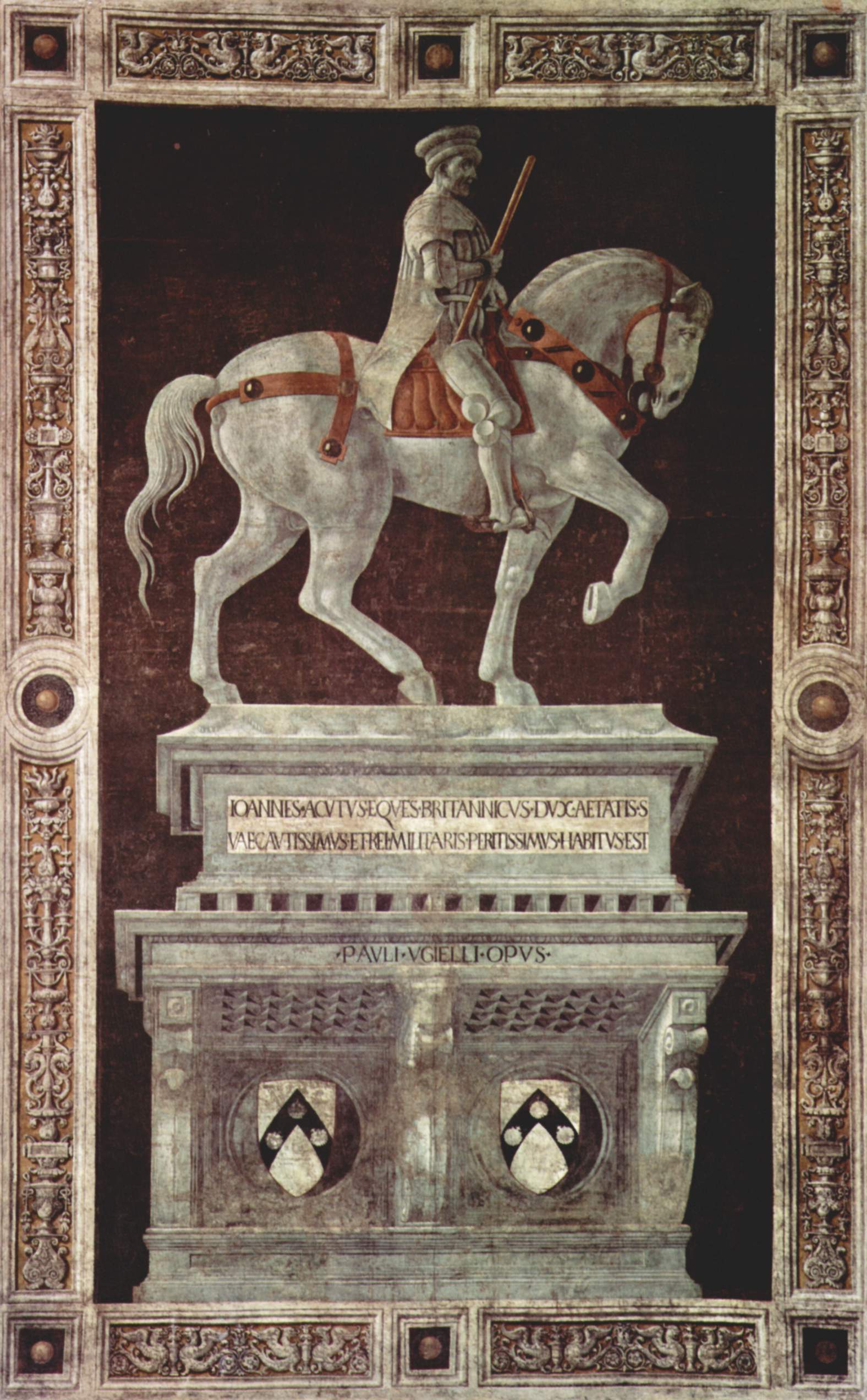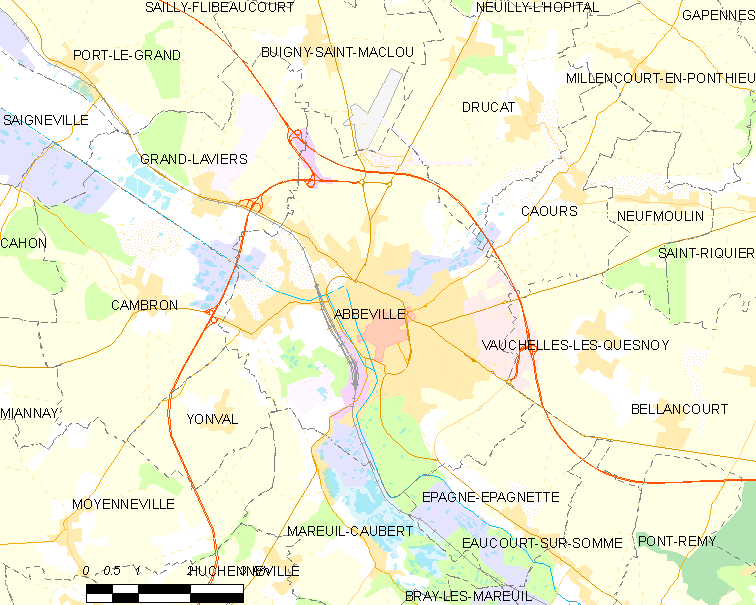|
Lances Fournies
The lance fournie (French: "equipped lance") was a medieval equivalent to the modern army squad that would have accompanied and supported a man-at-arms (a heavily armoured horseman popularly known as a "knight") in battle. These units formed companies under a captain either as mercenary bands or in the retinue of wealthy nobles and royalty. Each lance was supposed to include a mixture of troop types (the men-at-arms themselves, lighter cavalry, infantry, and even noncombatant pages) that would have guaranteed a desirable balance between the various components of the company at large; however, it is often difficult to determine the exact composition of the lance in any given company as the available sources are few and often centuries apart. A lance was usually led and raised by a knight in the service of his liege, yet it is not uncommon in certain periods to have a less privileged man, such as a serjeants-at-arms, lead a lance. More powerful knights, also known as a knight banner ... [...More Info...] [...Related Items...] OR: [Wikipedia] [Google] [Baidu] |
Medieval
In the history of Europe, the Middle Ages or medieval period lasted approximately from the late 5th to the late 15th centuries, similar to the Post-classical, post-classical period of World history (field), global history. It began with the fall of the Western Roman Empire and transitioned into the Renaissance and the Age of Discovery. The Middle Ages is the middle period of the three traditional divisions of Western history: classical antiquity, the medieval period, and the modern history, modern period. The medieval period is itself subdivided into the Early Middle Ages, Early, High Middle Ages, High, and Late Middle Ages. Population decline, counterurbanisation, the collapse of centralized authority, invasions, and mass migrations of tribes, which had begun in late antiquity, continued into the Early Middle Ages. The large-scale movements of the Migration Period, including various Germanic peoples, formed new kingdoms in what remained of the Western Roman Empire. In the ... [...More Info...] [...Related Items...] OR: [Wikipedia] [Google] [Baidu] |
Matthew Bennett (historian)
Matthew Bennett (born 1954) is a historian specialising in Medieval warfare. He taught as a Senior Lecturer in the Department of Communication and Applied Behavioural Science at The Royal Military Academy, Sandhurst, UK, for thirty years, retiring in 2014. He holds a degree in History and an MA in Medieval History from King's College, London, where he studied under R. Allen Brown, and is a fellow of both the Society of Antiquaries and the Royal Historical Society The Royal Historical Society, founded in 1868, is a learned society of the United Kingdom which advances scholarly studies of history. Origins The society was founded and received its royal charter in 1868. Until 1872 it was known as the Histori .... In 2011 he was awarded a PhD By Means of Published Works by the University of Northampton. He is the author and editor of numerous books and articles on Medieval warfare. Publications * *With Nicholas Hooper: * *With Jim Bradbury, Kelly DeVries, Iain Dickie, and Phy ... [...More Info...] [...Related Items...] OR: [Wikipedia] [Google] [Baidu] |
Chorągiew (military Unit)
Chorągiew (; literally: "banner") was the basic administrative unit of the Polish and Lithuanian cavalry from the 14th century. An alternative name until the 17th century was '' Rota''. 14th to 17th centuries Between the 14th and 17th century the ''Chorągiew'' was composed of smaller sub-units – the ''Poczet''. Types of ''Chorągiew'' were: * Chorągiew ziemska (District banner), formed by knights of a district. * Chorągiew rodowa (Clan banner), formed by clans. * Chorągiew nadworna (Court banner), formed by troops of the King. 15th century (2nd half) to 18th century (1st half) In the cavalry, since the second half of the 15th century until the first half of the 18th century, a ''Chorągiew'' was formed according to the "companion system" (system zaciągu towarzyskiego). See: '' Towarzysz'' (companion). Types of ''Chorągiew'' were: * Chorągiew husarska (Hussar banner), formed by Hussars. * Chorągiew lekka ("Light" banner), formed by light-cavalry. * Chorągiew pan ... [...More Info...] [...Related Items...] OR: [Wikipedia] [Google] [Baidu] |
Retinue
A retinue is a body of persons "retained" in the service of a noble, royal personage, or dignitary; a ''suite'' (French "what follows") of retainers. Etymology The word, recorded in English since circa 1375, stems from Old French ''retenue'', itself from ''retenir'', from the Latin ''retenere'': to hold back or retain. Employment Such retainers were not necessarily in the domestic service or otherwise normally close to the presence of their lord, but also include others who wore his livery (a kind of uniform, in distinctive colours) and claimed his protection, such as musicians and tutors. Some were a source of trouble and abuse in the 15th and early 16th century. Often their real importance was very different from their rank: on the one hand, sinecures and supernumerary appointments allowed enjoying benefits without performing full service. On the other hand, 'having the ear' of the master can allow one to act as a confidant in an informal capacity; or in some cases, even as a ... [...More Info...] [...Related Items...] OR: [Wikipedia] [Google] [Baidu] |
Poland
Poland, officially the Republic of Poland, is a country in Central Europe. It is divided into 16 administrative provinces called voivodeships, covering an area of . Poland has a population of over 38 million and is the fifth-most populous member state of the European Union. Warsaw is the nation's capital and largest metropolis. Other major cities include Kraków, Wrocław, Łódź, Poznań, Gdańsk, and Szczecin. Poland has a temperate transitional climate and its territory traverses the Central European Plain, extending from Baltic Sea in the north to Sudeten and Carpathian Mountains in the south. The longest Polish river is the Vistula, and Poland's highest point is Mount Rysy, situated in the Tatra mountain range of the Carpathians. The country is bordered by Lithuania and Russia to the northeast, Belarus and Ukraine to the east, Slovakia and the Czech Republic to the south, and Germany to the west. It also shares maritime boundaries with Denmark and Sweden. ... [...More Info...] [...Related Items...] OR: [Wikipedia] [Google] [Baidu] |
Serjeanty
Under feudalism in France and England during the Middle Ages, tenure by serjeanty () was a form of tenure in return for a specified duty other than standard knight-service. Etymology The word comes from the French noun , itself from the Latin , "serving", the present participle of the verb , "to keep, preserve, save, rescue, deliver". "Sergeant" is derived from the same source, though developing an entirely different meaning. Origins and development Serjeanty originated in the assignation of an estate in land on condition of the performance of a certain duty other than knight-service, usually the discharge of duties in the household of the king or a noble. It ranged from non-standard service in the king's army (distinguished only by equipment from that of the knight), to petty renders (for example the rendering of a quantity of basic food such as a goose) scarcely distinguishable from those of the rent-paying tenant or socager. The legal historians Frederick Pollock and Freder ... [...More Info...] [...Related Items...] OR: [Wikipedia] [Google] [Baidu] |
White Company
The White Company ( it, Compagnia Bianca del Falco) was a 14th-century English mercenary Company of Adventure ( it, Compagnia di ventura), led from its arrival in Italy in 1361 to 1363 by the German Albert Sterz and later by the Englishman John Hawkwood. Although the White Company is the name by which it is popularly known, it was initially called the Great Company of English and Germans and would later often be referred to as the English Company (Italian: ''Compagnia degli Inglesi'', Latin: ''Societas Angliciis''). Origins of the name No medieval source explains the company's name. The traditional view is that it is a reference to the brightly polished armour of the men-at-arms. However, William Caferro has suggested that it was because the company originally wore white surcoats. This view might be supported by the fact that mercenaries led by Arnaud de Cervole in France at this time were known as ''bandes blanches.'' Makeup of the company Despite it being commonly referred to ... [...More Info...] [...Related Items...] OR: [Wikipedia] [Google] [Baidu] |
Livres
The (; ; abbreviation: ₶.) was one of numerous currencies used in medieval France, and a unit of account (i.e., a monetary unit used in accounting) used in Early Modern France. The 1262 monetary reform established the as 20 , or 80.88 grams of fine silver. The was a gold coin of one minted in large numbers from 1360. In 1549, the was decreed a unit of account, and in 1667 it officially replaced the . In 1720, the was redefined as 0.31 grams of pure gold, and in 1726, in a devaluation under Louis XV, as 4.50516 grams of fine silver. It was the basis of the revolutionary French franc of 1795, defined as 4.5 grams of fine silver exactly. Circulating currency In France, the was worth 240 deniers (the "Tours penny"). The latter were initially minted by the abbey of Saint Martin in the Touraine region of France. Soon after Philip II of France seized the counties of Anjou and Touraine in 1203 and standardized the use of the there, the began to supersede the (Paris pou ... [...More Info...] [...Related Items...] OR: [Wikipedia] [Google] [Baidu] |
Guisarme
A guisarme (sometimes gisarme, giserne or bisarme) is a pole weapon used in Europe primarily between 1000 and 1400. Its origin is likely Germanic, from the Old High German , literally "weeding iron". Like many medieval polearms, the exact early form of the weapon is hard to define from literary references, and the identification of surviving weapons can be speculative. Possible interpretations of form Two main modern schools of thought exist: # Like most polearms the guisarme was developed by peasants by combining hand tools with long poles: in this case by putting a pruning hook onto a spear shaft. According to Sir Guy Francis Laking, among the polearms, the guisarme was second only to the spear in importance for the medieval soldier class. In fact, it was so effective by the 13th century there was active support for its banishment from the battlefield. While early designs were simply a hook on the end of a long pole, later designs implemented a small reverse spike on the back ... [...More Info...] [...Related Items...] OR: [Wikipedia] [Google] [Baidu] |
Abbeville
Abbeville (, vls, Abbekerke, pcd, Advile) is a commune in the Somme department and in Hauts-de-France region in northern France. It is the chef-lieu of one of the arrondissements of Somme. Located on the river Somme, it was the capital of Ponthieu. Its inhabitants are called the ''Abbevillois''. Geography Location Abbeville is located on the river Somme, from its modern mouth in the English Channel. The majority of the town is located on the east bank of the Somme, as well as on an island. It is located at the head of the Abbeville Canal, and is northwest of Amiens and approximately from Paris. It is also as the crow flies from the and the English Channel. In the medieval period, it was the lowest crossing point on the Somme and it was nearby that Edward III's army crossed shortly before the Battle of Crécy in 1346. Just halfway between Rouen and Lille, it is the historical capital of the County of Ponthieu and maritime Picardy. Quarters, hamlets and local ... [...More Info...] [...Related Items...] OR: [Wikipedia] [Google] [Baidu] |
Charles The Bold
Charles I (Charles Martin; german: Karl Martin; nl, Karel Maarten; 10 November 1433 – 5 January 1477), nicknamed the Bold (German: ''der Kühne''; Dutch: ''de Stoute''; french: le Téméraire), was Duke of Burgundy from 1467 to 1477. Charles's main objective was to be crowned king by turning the growing Burgundian State into a territorially continuous kingdom. He declared himself and his lands independent, bought Upper Alsace and conquered Zutphen, Guelders and Lorraine, uniting at last Burgundian northern and southern possessions. This caused the enmity of several European powers and triggered the Burgundian Wars. Charles's early death at the Battle of Nancy at the hands of Swiss mercenaries fighting for René II, Duke of Lorraine, was of great consequence in European history. The Burgundian domains, long wedged between the Kingdom of France and the Habsburg Empire, were divided, but the precise disposition of the vast and disparate territorial possessions involved ... [...More Info...] [...Related Items...] OR: [Wikipedia] [Google] [Baidu] |
Duke Of Burgundy
Duke of Burgundy (french: duc de Bourgogne) was a title used by the rulers of the Duchy of Burgundy, from its establishment in 843 to its annexation by France in 1477, and later by Holy Roman Emperors and Kings of Spain from the House of Habsburg who claimed Burgundy proper and ruled the Burgundian inheritance in the Low Countries. The Duchy of Burgundy was a small portion of the traditional lands of the Burgundians west of the river Saône which, in 843, was allotted to Charles the Bald's West Franks, kingdom of West Franks. Under the Ancien Régime, the Duke of Burgundy was the premier lay Peerage of France, peer of the kingdom of France. Beginning with Robert II of France, the title was held by the House of Capet, Capetians, the French royal family. It was granted to Robert's younger son, Robert I, Duke of Burgundy, Robert, who founded the House of Burgundy. When the senior line of the House of Burgundy became extinct, it was inherited by John II of France through proximity of ... [...More Info...] [...Related Items...] OR: [Wikipedia] [Google] [Baidu] |






